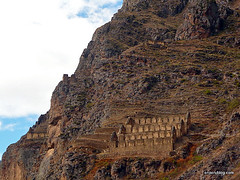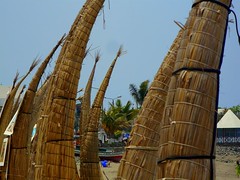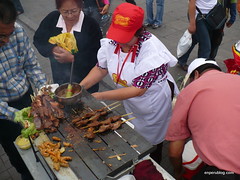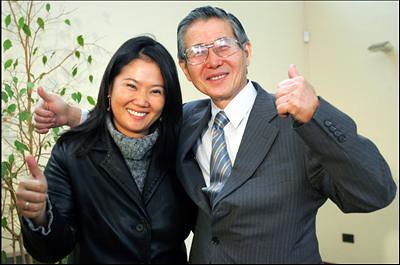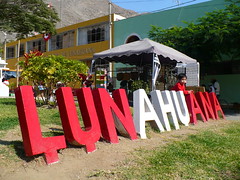The pre-Columbian town of Makatampu stood on the outer edges of the city of Maranga, and as its name suggests, it was a tambo, or resting place, set in the scenery of fields irrigated by two artificial aqueducts. No longer standing – the complex was destroyed in the 1940s to may way for the construction of factories on the old hacienda Conde de las Torres – it was said to have been an important site.
Category: "History"
Ruins of Pachacamac
The history of pre-Hispanic Lima is deeply entwined with Pachacamac. Worshipped across the central Andes since before the Inca conquest, the powerful creator god Pacha Kamaq is even revered today, almost 500 years after the Spanish conquest by Catholics in Lima. Today this powerful being has taken shape as the Cristo Morado and has been absorbed into Catholicism, and just as he is today, this ancient figure was also known as the Lord of the Earthquakes.
3000 year old temples discovered in Lambayeque
Two ancient temples thought to be about 3,000 years old, from the time when high civilisation established itself in northern Peru, have been uncovered in the archaeological complex of Collud-Zarpán.
Convento de San Francisco
Every tourist who visits the colonial heart of Lima visits the San Francisco convent and descends into the depths of its catacombs, filled with the bones of the first generations of Spanish settlers. […] The church is also home to one of Lima’s most important libraries. Built in the 18th century, 25 thousand volumes of books are found here, many are now almost 500 years old. The furniture found here is original, the cedar-wood chairs and tables were once used by Franciscans when studying. [..]
University of San Marcos
San Marcos was founded in 1551 as the Real y Pontificia Universidad de la Ciudad de los Reyes de Lima (Real and Pontifical University of the City of the Kings of Lima), less than two decades after the founding of the city of Lima. With a royal decree issued by the King of Spain Carlos I and with a papal bull, it claims to be the first officially recognised university in the Americas – Santo Domingo’s was founded first at the time of the conquest of Peru, but didn’t receive recognition from the King until afterwards.
Klaus Koschmieder – New Chachapoyan Discoveries
German archaeologist Klaus Koschmieder has spent three years exploring and investigating an area rich in long lost archaeological remains of the Chachapoyas culture. Despite his amazing success in discovering previously unknown cliff face sarcophagi on an ever-reducing budget, his project may come to an abrupt end thanks to Peru’s bureaucratic and incompetent Instituto Nacional de Cultura (INC).
Lima’s Archaeological Sites (.KMZ)
I’ve been putting together a map of some of Lima’s estimated 10,000 archaeological sites. The vast majority of these, as shown in the Lima Precolombina series, are found in the middle of regular residential areas of Lima and include Inca palaces, towering pyramids and the ruins of towns and cities.
Since posting Glorious Pre-Columbian Lima, I’ve had dozens of requests to make the Google Earth placemarks I used available as a downloadable .kmz file. This is something I definitely want to do, but with so many sites it will always be a work in progress. In the course of mapping the pre-Columbian artificial water channels the Spanish thought were rivers, for example, I noticed 3 archaeological sites I had no idea existed.
Bar Maury and the Pisco Sour
Californian immigrant Victor Morris arrived in the city in the early 1900s and set up a bar that operated until 1933.
It is said that it was here in Bar Morris that the Pisco Sour was first conceived, invented either by Victor or one of his bar staff, based on the recipe for whiskey sour.
The new cocktail was a huge hit, and the city’s biggest hotels, such as the Hotel Bolivar and Hotel Maury began serving their own versions to their international clients.
Bar Maury took up the mantel, and according to barman Eloy Cuadros, who is now part of the furniture, it is here the recipe was perfected and it is their version that has spread across the country. It seems very plausible – Eloy served me the best Pisco Sour I have ever had.
Glorious Pre-Columbian Lima
When Francisco Pizarro arrived in the Rimac valley, founding the city of Los Reyes on the 18th of January 1535, he arrived in place quite different from what you might imagine. Here was an expansive green and fertile land, in the middle of the Peruvian desert coast, home tens of thousands living under the rule of the Incas. Where Lima is found today was once a land of pyramids and palaces, cities and farms, with complex irrigation canals spanning kilometres in length bringing water to every home.
Taulichusco, Lima’s Last Curaca
The Inca Empire had all but collapsed, the Inca capital of Q’osco had been conquered and a puppet emperor placed on the thrown. By following the Inca road from Jauja to Pachacamac, conquistador Pizarro was back on the coast with many of his men looking for a place to found his city. The choice was obvious… the green paradise spanning out from the river Rimac, a vast urban and agricultural area home to tens of thousands of indigenous who had transformed the desert with complex irrigation systems and who had constructed countless towering truncated pyramids that could be seen for miles around.
Maranga and the Lima Culture
In the heart of Pre-Columbian Lima, at the time of the arrival of the Spanish, a vast city was found south of the Rimac River between modern day Lima and Callao. Certainly the administrative centre of power in northern part of the Inca province of Ischma, with Pachacamac an important centre of the south, this city was built long before by the native “Lima Culture” who lived here. Today most of this important complex has been destroyed through the efforts of the Peruvian Government, the University of San Marcos and the Peruvian people in the earlier part of the last century – a time when Peruvians couldn’t care less about their ancient past. Remaining though, and some now finally being restored, are several large huacas, pyramidal mounds, that bare testament to Lima’s long history.
Huaca Mateo Salado
Found at at the Plaza de la Bandera where the district of Pueblo Libre meets Breña and Lima Cercado, the ruins of five pyramids that make up this Lima Culture complex called Huaca Mateo Salado tower over the surrounding modern houses.



